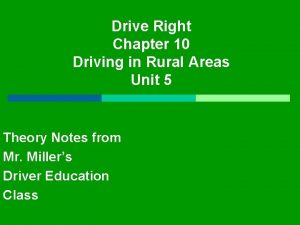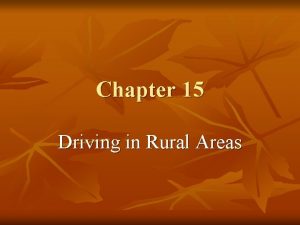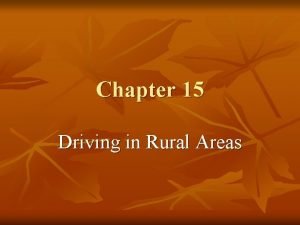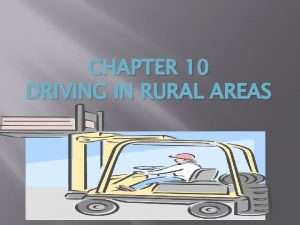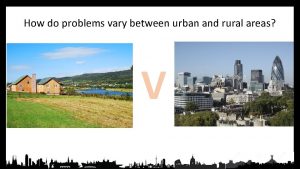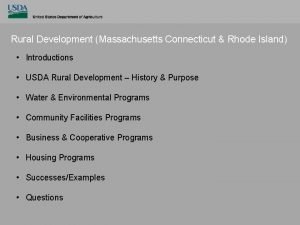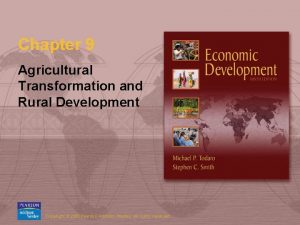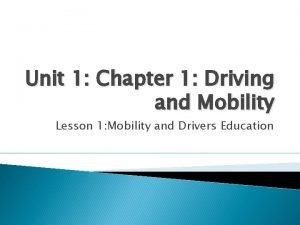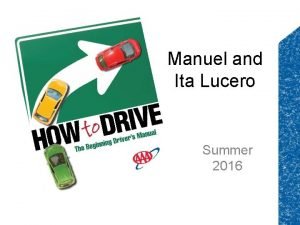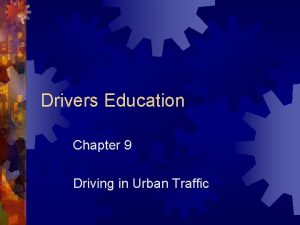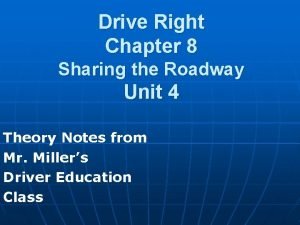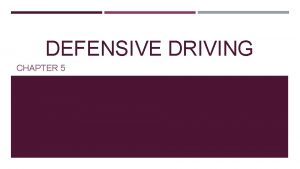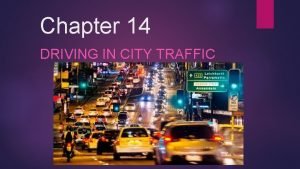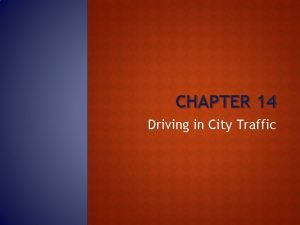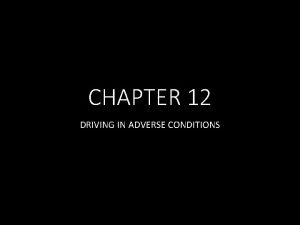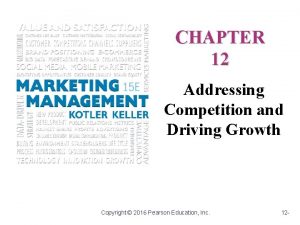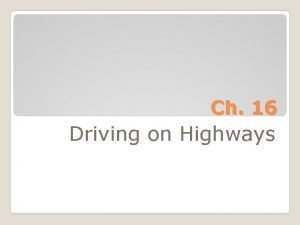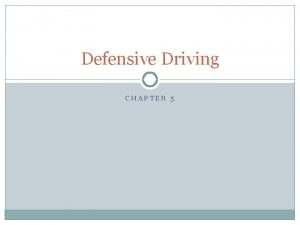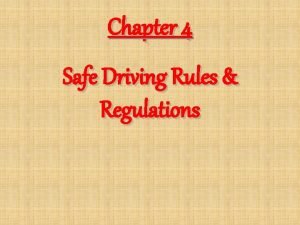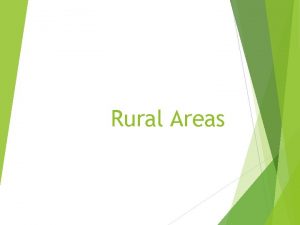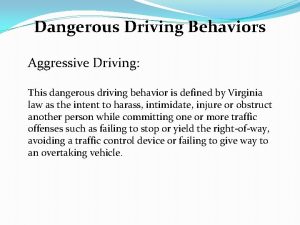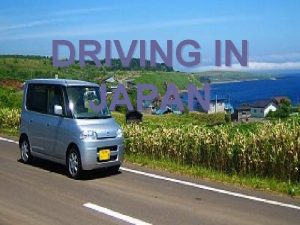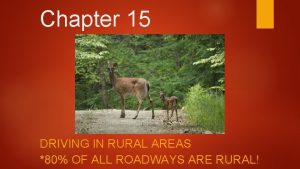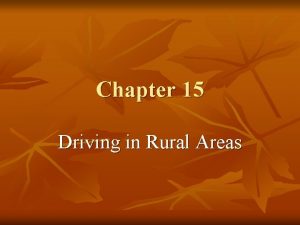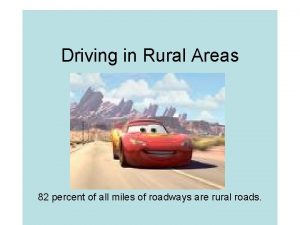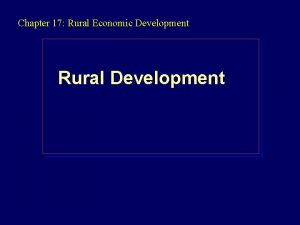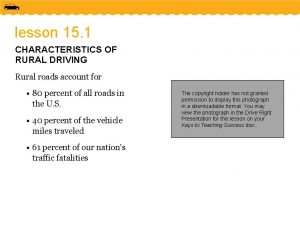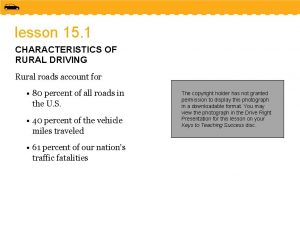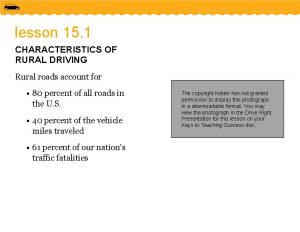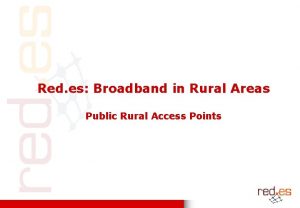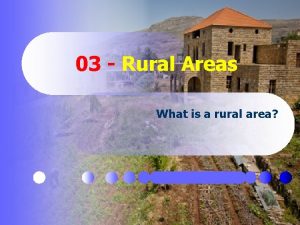Chapter 10 Driving in Rural Areas 10 1






















- Slides: 22

Chapter 10 Driving in Rural Areas

10. 1 Characteristics of Rural Traffic

Things to think about… • 82% of all miles of roadways in the US are rural roads. • Typically less traffic • BUT… – Collisions in rural areas account for nearly twice as many highway deaths as collisions in urban areas.

Roadways • Roads are made from all different types of materials. • Paved, dirt, gravel, smooth, very poor condition… • Lack of adequate lighting • Conditions can change suddenly with little warning.

• Speed effects: Speed • Line of sight • Stopping distance • Vehicle control • Amount of damage and injury in the event of a collision • Some have speed limits of 55 mph • Some states even higher! * Always use your common sense and never drive faster than conditions permit.

Traffic Controls • Traffic controls provide advance information and warning of • Hazards that you cannot yet identify • Major intersections ahead • Unusual or hazardous conditions • Traffic channeled into reduced space

Roadside Hazards • Shoulders maybe uneven with the edge of the roadway. • Bridges, guardrails, bushes or trees may be near the road’s edge. • A steep slope might run from the shoulder down a hill or drainage ditch.

10. 2 Using Basic Skills in Rural Areas

Quiet rural traffic scene can change quickly with little or no warning!

Visual Search Pattern • 12 -15 second search range • Are we going to look farther or closer if we are driving 55 mph compared to 25 mph?

Curves • Rural roads typically have many curves. • Collisions occur on curves because speed on their approach is too great. • You typically will see a warning sign warning you to slow down because a curve or “dangerous curve” is ahead.

Hills • Unless they have very steep slopes, hills are usually not marked. • Hills restrict your line of sight. • Slowdown as you approach the crest of the hill.

10. 3 Passing and being passed on rural roads.

Deciding to pass… • Is it worth it to pass? • Is it legal to pass? • Is it safe to pass? * Consider passing if you can answer YES to all these questions!

When NOT to pass • No passing on Roads going up or down hill • No passing at intersections • Within in 100 feet before a railroad • On a 2 lane bridge or underpass • On CURVES!!!! • When the vehicle ahead is traveling at or near the posted limit

• When line of sight is limited by fog, snow, or rain • When you cannot complete a pass before the start of a no passing zone • Anytime oncoming traffic is too close • When you will be stopping or turning soon. • Only pass one vehicle at a time.

Being Passed • It is illegal to not let someone pass you! • You may NOT speed up, slow down, and/or move to the side to prevent someone from passing you.

10. 4 Rural Situations You Might Encounter

Slow-Moving Vehicles • Is a vehicle that is unable to travel at highway speed. • Not designated, nor intended, as means for personal transportation – Farm vehicles – Street cleaner – Garbage trucks • When driving at higher speed, you will rapidly approach a slow moving vehicle. • Try to identify these vehicles as early as possible.

Animals • Can easily be frightened and dart out into the middle of the road. • Hitting a large animal can damage your vehicle, and serious injury or death to you and your passengers. • Areas where large wild animals are common, reduce your speed and search a much wider area than usual.

Railroad Crossings • Usually don’t have complete controls (lights and gate) • Travel faster through rural areas! • Never cross a railroad crossing until you know it is absolutely safe! ***Remember when a vehicle and a train collide, the train always wins!

 Drive right chapter 10 answer key
Drive right chapter 10 answer key Chapter 15 driving in rural areas
Chapter 15 driving in rural areas Chapter 15 driving in rural areas
Chapter 15 driving in rural areas Chapter 10 activity 10-1 drivers ed
Chapter 10 activity 10-1 drivers ed Difference between urban and rural areas
Difference between urban and rural areas Usda rural areas in massachusetts
Usda rural areas in massachusetts Chapter 9 agricultural transformation and rural development
Chapter 9 agricultural transformation and rural development Chapter 9 agricultural transformation and rural development
Chapter 9 agricultural transformation and rural development Chapter 1 driving and mobility
Chapter 1 driving and mobility Chapter 1 managing risk when driving
Chapter 1 managing risk when driving Cross traffic is eliminated on controlled access expressway
Cross traffic is eliminated on controlled access expressway Drive right chapter 9
Drive right chapter 9 A depressant drug drivers ed
A depressant drug drivers ed Drive right chapter 8
Drive right chapter 8 In extreme cases an aggressive driver may
In extreme cases an aggressive driver may Chapter 14 driving in city traffic
Chapter 14 driving in city traffic Chapter 14 driving in city traffic
Chapter 14 driving in city traffic To give yourself more time for the i pde process at night
To give yourself more time for the i pde process at night Responsive anticipation and creative anticipation
Responsive anticipation and creative anticipation Driving in adverse conditions
Driving in adverse conditions Describe velocitation and highway hypnosis
Describe velocitation and highway hypnosis Most accidents are caused by _________ driving error.
Most accidents are caused by _________ driving error. Motorist
Motorist
